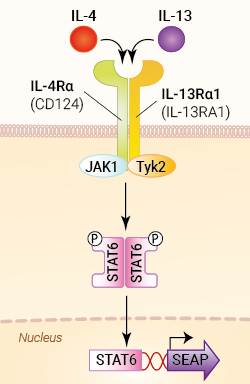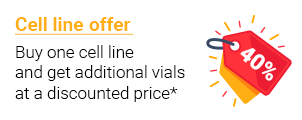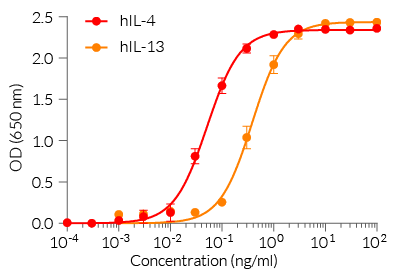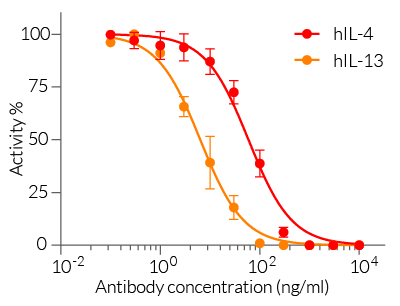IL-4 & IL-13 Reporter HEK 293 Cells
| Product | Unit size | Cat. code | Docs. | Qty. | Price | |
|---|---|---|---|---|---|---|
|
HEK-Blue™ IL-4/IL-13 Cells Human IL-4 / IL-13 SEAP Reporter Cells |
Show product |
3-7 x 10e6 cells |
hkb-il413
|
|||
|
HEK-Blue™ IL-4/IL-13 vial Additional cell vial |
Show product |
3-7 x 10e6 cells |
hkb-il413-av
|
![]() Cytokine offer: For each cytokine reporter cell line purchased, get a free vial of the matching cytokine.
Cytokine offer: For each cytokine reporter cell line purchased, get a free vial of the matching cytokine.
IL-4 & IL-13 responsive STAT6-SEAP reporter assay

Signaling pathway in HEK-Blue™ IL-4/IL-13 cells
Companion products
• Recombinant human IL-4
• Recombinant human IL-13
• Anti-hIL4R (Dupilumab)
HEK-Blue™ IL-4/IL-13 cells are designed to monitor human IL-13-induced STAT6 stimulation or inhibition. This colorimetric bioassay can be used for screening activatory molecules, such as engineered cytokines, or inhibitory molecules, such as neutralizing antibodies.
HEK-Blue™ IL-4/IL-13 cells respond specifically to recombinant human IL-4 and recombinant human IL-13. The reliable and consistent performance of HEK-Blue™ IL-4/IL-13 cells makes them suitable for release assays of therapeutic molecules that inhibit IL-4 or IL-13 signaling, such as Dupilumab, a therapeutic monoclonal antibody targeting the common IL-4Rα subunit of the IL-4 and IL-13 receptors (see figures).
Key features
- Readily assessable STAT6-SEAP reporter activity
- Convenient readout using QUANTI-Blue™ Solution
- High sensitivity to human (h) IL-4 and hIL-13
- Stability guaranteed for 20 passages
Applications
- Therapeutic development
- Drug screening
- Release assay
IL-4 and IL-13 are cytokines that play an important role in the regulation of inflammation and immune responses.
All InvivoGen products are for internal research use only and not for human or veterinary use.
Back to the topSpecifications
Cell type: Epithelial
Tissue origin: Human Embryonic Kidney
Target: IL-4 and IL-13
Specificity: Human
Reporter gene: SEAP
Antibiotic resistance: Blasticidin, Zeocin®
Detection range: 20 pg/ml -100 ng/ml (hIL-4), 0.2 ng/ml - 100 ng/ml (hIL-13)
Growth medium: Complete DMEM (see TDS)
Growth properties: Adherent
Mycoplasma-free: Verified using Plasmotest™
Quality control: Each lot is functionally tested and validated.
Back to the topContents
HEK-Blue™ IL-4/IL-13 (hkb-il413)
- 1 vial containing 3-7 x 106 cells
- 1 ml of Blasticidin (10 mg/ml)
- 1 ml of Zeocin® (100 mg/ml)
- 1 ml of Normocin® (50 mg/ml)
-
1 ml of QB reagent and 1 ml of QB buffer (sufficient to prepare 100 ml of QUANTI-Blue™ Solution, a SEAP detection reagent)
HEK-Blue™ IL-4/IL-13 vial (hkb-il413-av)
- 1 vial containing 3-7 x 106 cells
![]() Shipped on dry ice (Europe, USA, Canada and some areas in Asia)
Shipped on dry ice (Europe, USA, Canada and some areas in Asia)
Notification: Reference #hkb-il413-av can only be ordered together with reference #hkb-il413.
Back to the topDetails
Cell line description
HEK-Blue™ IL-4/IL-13 cells were generated by stable transfection of the human embryonic kidney HEK293 cell line with the gene encoding human STAT6 to obtain a fully active STAT6 pathway. The other genes of the IL-4/IL-13 pathway are naturally expressed in these cells. These cells were further transfected with a STAT6-inducible secreted embryonic alkaline phosphatase (SEAP) reporter. The binding of IL-4 or IL-13 to their receptor triggers a signaling cascade leading to STAT6 activation and the subsequent production of SEAP. This can be readily assessed in the supernatant using QUANTI-Blue™ Solution, a SEAP detection reagent.
HEK-Blue™ IL-4/IL-13 cells detect human (h) IL-4 and hIL-13 (see figures). Of note, they do not respond to hIFN-α or hIFN-β (see figures).
Back to the top










